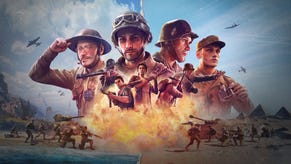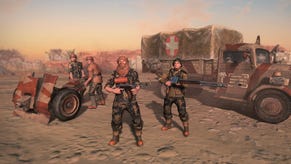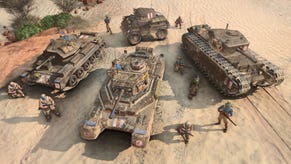Company of Heroes 3 is coming - and it feels like the original, but bigger
North Africa! The Mediterranean! Dynamic campaign! More!
Of all the things to like about Company of Heroes, I'm especially a fan of the conversations. Like any good RTS, these are games about make-believe, about moving little men around a battlefield, role-playing as one of those retired, amateur history enthusiasts with too much spare time, who are themselves role-playing as a Second World War commander. It's about doing the voices, making the sounds of the guns, living out your twilight years with no-one but the model army in your basement.
I am not selling this! But still, the point is when the Americans parachute in all chipper like, or one of my little Russian comrades complains to another that "stealing my biscuits is not the Soviet way!", Company of Heroes is doing its job better than any RTS like it. And so, when Relic tells me that "humanising the battlefield" with more of these occasional barks is one of the "core pillars" of Company of Heroes 3, I'm delighted to hear it, probably even more than I am to hear about the fancy dynamic campaign or the wonderful southern-Med setting. It's early days - honestly, very early days, from what I played - but this, above all, seems to be the theme with CoH 3: it's all about recognising what was good about the last two games, and just doing more of it.
Much of this is likely down to the approach Relic has taken this time around. The studio has some cracking history with RTS games - alongside the lastingly popular Company of Heroes ones, the first two Warhammer 40,000: Dawn of War games and their expansions are glorious, bigger-than-cult hits - but Dawn of War 3's reception in 2017 was mixed. It crossed the traditional RTS fare with a very light sprinkling of MOBA elements, like more impactful character abilities and more defined "lanes" to the maps, and, for better or worse, it wasn't really what fans were after.
Relic's response has been to do more or less the exact opposite with CoH 3, placing a very heavy emphasis on player feedback. It's set to launch some time in 2022, but you can sign up to play an early slice of it from today, as part of a "CoH-Development" plan that mirrors what other studios like Amplitude (also publishing through SEGA), have done with Humankind. On the surface, it seems like a pretty direct reaction to what happened with Dawn of War 3.
"That's absolutely part of it," says executive producer David Littman. "Any time we release a game - any time any company releases a game - you have to do a post mortem and look at, you know, how was it received? And what was the experience for players?
"I think on DoW 3, it was a pretty good game - I mean, it's a fun game to play! It got reviewed, actually, pretty well - but the one thing we took away from that was: hey, you know, we heard some things from players after it was launched, and in the leadup to launch, and if we could have talked to them more, and really listened to what they were asking for, it could have made a difference in the way it was perceived."
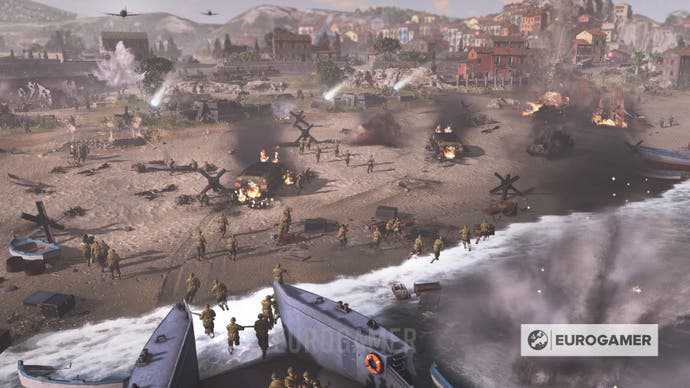
There's a difference between the two series, he notes - Dawn of War "had it a little harder", insofar as its audience is somewhat split between the two games, as the first and second are quite different, whereas Company of Heroes' fans generally like parts of both - but the point stands: things could have been different for Dawn of War 3 if the studio had gathered some feedback a little earlier on. (As an aside, when asked whether Dawn of War's on ice for the foreseeable future, Littman's response was "from a Relic standpoint - and a SEGA standpoint - it's a great franchise, and absolutely we're always looking to see what we should be doing next, Relic as a whole will just be looking at what games we want to be making, and everything's on the table".)
Back to Company of Heroes 3, and the impact of the player involvement is remarkably strong. Relic sent out around 500,000 emails to players and received about 60,000 responses, and then expanded that survey to wider strategy game players as well. "Probably the most interesting" result, Littman says, was at the first "summit" the studio held with ten players, when a new setting was discussed and all ten of the invited players unanimously voted for the Mediterranean and Northern Africa, in part because of what the history itself would mean for the gameplay. The alternative was the Pacific, which Relic was equally keen on, and the one-way result was a surprise.
At the first "summit" the studio held with ten players, when a new setting was discussed all ten of the invited players unanimously voted for the Mediterranean and Northern Africa, in part because of what the history itself would mean for the gameplay.
"We were like, wait, why? And all of them said from a PvP perspective, so multiplayer, that the armies are just not equal: the Japanese, the 'Axis' side, cannot compete with the US Marine Corps and all that the Allies brought there, especially with vehicles and tanks, and it just wouldn't really be a fair fight if they were fighting in our PvP. We would have had to do so much to the Japanese to buff them up a bit that it wouldn't be as authentic as our players are looking for. So this is amazing information to get really early on, our team really agreed with that assessment, they thought the same thing, and it all led us down to the Mediterranean."
There are more reasons for that being the players' choice of setting, namely the scenery itself being so varied - it was hard to get a real idea from what I played as, understandably given the build's earliness, graphical settings seemed to be stuck on the lower side, but in principle the scenery of the Med is gorgeous - but there's also the variation of the actual terrain. Verticality is a big thing in CoH 3, with height advantage allowing a squad to bypass the defensive buff another gets from being in cover. So, if you put a squad behind a mid-height wall, getting heavy cover protection, and another enemy attacks from a higher ledge or upper floor of a building, it's like your guys are out in the open.
That's one of many small-but-actually-quite-big changes to the moment-to-moment strategy. There's now a tactical pause, for instance, which is part of a push to appeal to a slightly wider strategy audience and is obviously completely optional (I more or less forgot to use it, given the action-per-minute habits of being an RTS player) but allows you to approach PvE games in a much slower, more more careful way, like you would when using pauses or slow-mo in Total War. Resource points return to how they were in the first CoH, with different ones split between Fuel and Munitions resources, so you can target your attacks behind enemy lines for some more specific disruption. And one of the biggest additions: breaching.
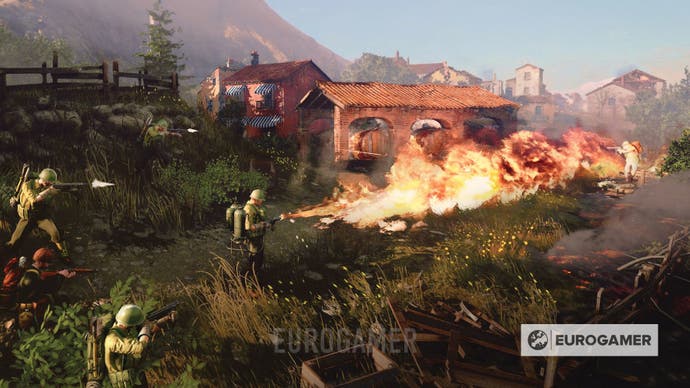
Andrew Deneault, CoH 3's lead campaign designer, explained that in more depth. "In the early phases of the game in particular, it's difficult to dislodge units from a garrisoned structure, and when some of those structures have varying health levels, and a varying number of hold slots or garrison slots, so you can pack a lot of squads in there, the players basically said: we need improved tools that don't include upgrades or the spending of munitions or tech upgrades, I just want a way that is organic to gameplay to be able to kick in and out of a garrison."
Basically, in previous CoH games you can rush a load of units to a building early on and they become very hard to dislodge. In CoH 3 however, most squads can run up to a building and with the press of a button, breach it by lining up outside, kicking down the door and lobbing in a grenade - usually killing the whole enemy squad garrisoned within - and taking their place. What's great about it right away is the balance to it, though: it's easy to do, but your squad can still be picked off by another enemy elsewhere while they're breaching. And there's a skill to avoiding it, as being breached yourself means your squad is locked into the building they're in, so picking and choosing when to garrison a squad and micromanaging them in and out of there is key.
Beyond that, there are other tweaks that come, again, from feedback on the previous games. Vehicles last slightly longer, but losing them is supposed to be more impactful now. There are slightly fewer vehicles in the battles I've experienced so far, and there's a longer time where lighter vehicles are relevant, before the heavy ones are unlocked. And there's generally a heavier focus on infantry combat overall, with more unit variety, and slightly more things to micromanage - a unit gaining veterancy now gives you a choice of two upgrades, for instance, usually one of two active abilities like a brief burst of more accurate fire, a silent knife-throw, or sprinting from cover to cover. That said, as much as there's an ever so slightly heavier infantry focus in CoH 3, Littman was keen to tease the "incredible flanking tank manoeuvres" and "all that comes with the beautiful, incredible deserts that we're building" when it comes to North Africa in particular.
There's generally a heavier focus on infantry combat overall, with more unit variety, and slightly more things to micromanage.
On the single-player front, most promising is how the dynamic campaign and the RTS missions themselves weave together (or at least in theory - my experience was pretty limited with the campaign, thanks to a few recurring hard crashes to desktop after battles that forced me to replay them and really slowed progres - again though, understandable: it's very early and there is the small matter of a pandemic on at the moment).

The campaign takes place across the whole of Italy, with the most factions ever, apparently, although the specifics are all still somewhat up in the air. There's a huge breadth of international forces available that feed into those factions - those namechecked so far include the Ghurkas and the American Canadian Special Forces - plus Italian resistance forces that you might rescue or recruit, and many more. Deneault was keen to emphasise the "sense of cultural fabric" that the narrative team is trying to tap into, and how the campaign will emphasise the relationships between forces like the British and Americans and how they unite (and occasionally fall out) in the process of the operation.
Broadly speaking, it feels like Total War light - not as arcadey as something like the Dawn of War: Dark Crusade campaign, but not as intricate or vast as Total War itself - and most of the emphasis is on a quite directional push as opposed to a big, all-conquering sandbox, starting at your landing place of choice in Italy and pushing to capture something or somewhere specific.
Deneault was keen to emphasise the "sense of cultural fabric" that the narrative team is trying to tap into, and how the campaign will emphasise the relationships between forces like the British and Americans and how they unite (and occasionally fall out) in the process of the operation.
One thing that feels slightly odd is the way troops appear, and actually fight, on that overworld "metamap" itself. RTS battles are only triggered when two companies attack each other, whereas individual units, which you can build from your overworld base, just act on the overworld. It means you can send some engineers down a road and have them simply blow up because of some unseen mines, or have a whole company pinned down by a single machine-gunner that was hiding in some trees. I'm not certain this really works, as it's a little jarring going from a metamap where a single machine-gunner has all that impact, down into a full company-on-company RTS battle where those gunners are killed and spawned en masse, and back out to the overworld where they're suddenly so important again.

On the other hand, there's a whole lot that does work, or at least seems to suggest as much at this early stage. Much of the campaign is about moving troops strategically from A to B, as it was in the war, I'd imagine, and there are some brilliant ways to experiment with that. You can focus on the navy, shipping armies up the coast and cutting out huge chunks of enemy forces or bombing them from sea; or you can capture airfields, build planes, and drop airborne companies directly onto an objective; or you can use partisan forces for espionage, and so on. The paratrooper method was a personal favourite: I dropped some directly on an assassination objective, triggering a kind of stealth mission on a small nighttime map based in a mansion's grounds. A squad of scouts, two snipers, and some paratroopers were all I had to take out several groups of guards, pick off the German commander and then make a break for it, which I did - but with just a single soldier left.
The obvious missing piece here is the PvP multiplayer, which is very much a big focus again but wasn't part of the preview. Talking to Littman there are some big plans for that over the next year or so until launch, though, with multiple public, pre-alpha PvP previews planned - and a lot of work already in place. "When we started talking to our players, the core gameplay and the PvP gameplay was our number one focus from the start, because close to half a million people are still playing Company of Heroes, and a majority of those players are playing against other players." PvP was the first thing the team needed to get right, he says, "and that started with new gameplay features, new factions, new abilities, and lots and lots and lots of maps and map variety." Players have actually been testing that "for three years", he told me, providing feedback and helping balance factions. In terms of maps, the plan is for CoH 3 to have more than any in the series.
The plan is to support the multiplayer in the long run - which should be a relief to anyone worried after the early end to support for Dawn of War 3's online modes.
Beyond that, again the plan is to support the multiplayer in the long run - which should be a relief to anyone worried after the early end to support for Dawn of War 3's online modes. Single-player will be supported over time - "we think it's a great campaign, we think we can add a lot to it after launch, similar to other games that have been doing it," which sounds like a nod to the fellow SEGA-published strategy campaigns like those of Total War. In terms of multiplayer it's things like "new battlegroups to add on to the factions, lots of maps, some player-generated content as well."
Interestingly, it'll be different to Company of Heroes 2 in one key way: "I think another lesson we've learned from our players," Littman says, "is that in Company of Heroes 2, commanders were sometimes seen as a bit pay-to-win because not everyone had access to them - and it wasn't necessarily full pay-to-win, just that some commanders may have been overpowered at launch, so if you buy an overpowered commander that hasn't been balanced correctly yet, it is kind of an advantage. So we totally understand that, and we want to make sure that that is not how we do Company of Heroes 3, that it's about being fair and balanced for everybody, people can all have access to the same content."
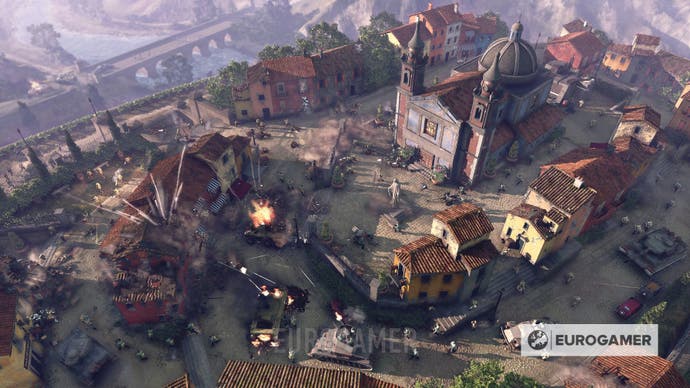
Ultimately, the recurring theme again is lessons learned. Part of Dawn of War 3's issue - despite it being perfectly fun - was how it did, at times, feel like playing a kind of existential crisis: is the RTS genre dying? Is this an RTS? Can a traditional RTS still be successful today? Relic, thankfully, very much seems to get it with Company of Heroes 3, and the most striking thing about the studios pitch for the game is the confidence, in the game itself but also the genre.
"As far as games played, it's just consolidated a bit, right?" Says Littman. "You have Age of Empires, you have Starcraft, you have Command and Conquer, you have Company of Heroes, you know, so you have your big four or five RTSs, whereas 25 years ago, there were 30 or 40 ones all coming out at the same time. So it's gotten smaller, but the audience, they're so passionate, and they still number in the millions - obviously, [otherwise] we wouldn't still be making these games, and so I think that's the main thing is just a smaller audience than it was 20, 30 years ago, but no less passionate of an audience that wants to play those games.
"Now for Company of Heroes 3, here's what we're doing: we're saying we recognise that the genre's a little bit smaller than it used to be, and so what can we do about that? And one of the things is, number one, just make the best game possible - players all gravitate towards great content and great games. But secondly, adding a dynamic campaign map for players who love single player, then it puts us more into a category of just a strategy game. And more like a Total War, people don't consider that an RTS, they just consider it a great strategy game. And so that's what we're doing with our campaign, and then we add in the tactical pause, that really does change the game.
"And so for us that is changing RTS a bit to be more for a strategy game, and that's why it's one of the things we're doing while not changing anything for the core PvP experience. We've kind of separated these two audiences a little bit within our game, to just let people play any way they want, at their own pace."
It really is early days, but on paper it sounds like a win-win - and what I've played so far is the full, history-nerd-in-the-basement treat.




